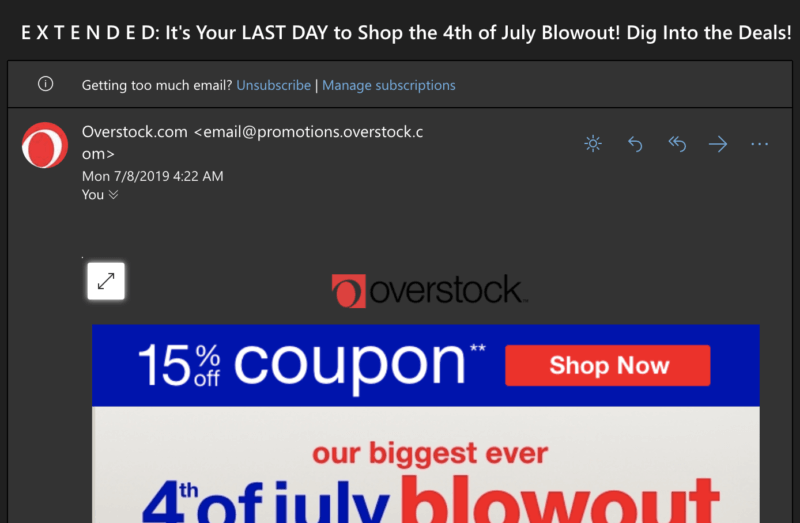The dog days of summer are upon us! There’s an astronomical explanation for the name, but for most of us the “dog days” are a time of year when the kids don’t have school, everyone
Email is still email, even in the summer
That’s right, just because people go on vacation doesn’t mean they cut the digital umbilical cord. Numerous articles offer advice on how to check email and still enjoy your vacation, while others estimate that 60% of employees check work email while on vacation, and
People just can’t seem to tear themselves away from those screens! Booking hotels, flights, tours
The fact of the matter is that email is vital even while on vacation – email is the documentation of our online lives.
Human patterns and e-commerce
It’s a safe bet that we’ll all continue shopping online, even poolside. E-commerce makes it almost a foregone conclusion that we will shop everywhere. But in the summer months, the when, where and how of our online shopping changes. During most of the
Those human patterns change in the summer as we go on vacation, have increased demands on our time because kids are out of school, or simply spend more time enjoying the weather. This change might translate into time-sensitive offers not having as much impact as during the rest of the year, except, of course, when tied to specific holidays like July 4th. American audiences have been trained to expect them. But, people are catching on to that tactic; they are getting accustomed to seeing these deals extended past the actual holiday:


The important thing to keep in mind is that the click may not happen exactly when you hoped it would. But, if your list is engaged, it could come a couple days later after the deal has been extended and people are back online.
Here are a few strategies to reach your audience during these “dog days.”
- All of the old rules apply. Grow your list organically and don’t cut corners when it comes to
opt in - It’s even more important to ensure that your emails are optimized for small screens. If the assumption is that we’re getting away from our desktops and laptops when we go on vacation, then we have to assume that we’re more reliant on our mobile phones and tablets. We’ve long assumed the small screen is the first screen experience and studies have shown that a second open on a larger screen is 65% more likely to click through. That doesn’t negate the fact that we have to ensure a good, usable and engaging experience on that first, smaller screen.
- Deliver authenticity in every email. Selling galoshes and warm wool clothing in the dead of summer is not delivering value or demonstrating that you’re operating in the same hemisphere as your recipients. Referencing sparklers, kids out of school, holidays, warm weather and other relevant topics help your product seem relatable to the recipients’ immediate needs. Test your calls-to-action and subject lines to ensure they’re not tone deaf. Track your opens, clicks and unsubscribes to ensure that any deviations or summer experiments are viewed through a baseline lens to capture your successes and failures. Remember, email is iterative. It requires time to build a good healthy list and a keen understanding of the metrics and analytics available to email marketers.
- Keep on top of your deliverability. No matter how great the offer, or clever the subject line, nothing matters if the email doesn’t arrive
to the inbox. Keeping track of spam complaints, blacklistings and unsubscribes will ensure that you understand the inbox potential of each segment. If you’re thinking summer is a great time to send a giant email to people who haven’t opened your emails for months and months, if not years and years, think again. The effects will be as deleterious as in other months. Use caution and set realistic boundaries for when you sunset unengaged recipients. These are the most likely sources of complaints and other actions that are bound to hurt your overall campaign and cause email bounce for engaged users to wind up in the junk. - Traveling means privacy. More accurately, people travelling on vacation may end up in certain areas that are now covered by stricter privacy regimes. GDPR is a great example. It applies to any person in the EU regardless of citizenship. A French citizen on vacation in Los Angeles isn’t covered by GDPR, but when they return to France they are. It is important to understand how the various privacy regimes may affect your business and follow practices that comply in accordance with these regimes.
We’re almost halfway through the dog days of summer. Soon all the heat, trips and sunburn will be a happy memory and people will fall back into their usual email habits. But, while there is still time, there’s no reason you can’t make small adjustments to your email program that will make this its
Opinions expressed in this article are those of the guest author and not necessarily Marketing Land. Staff authors are listed here.

